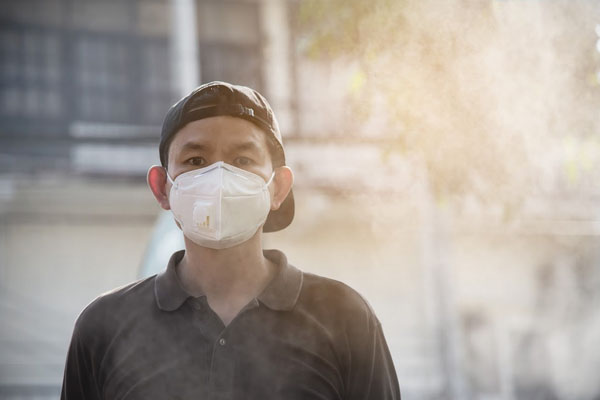
Breathing Easy: Understanding Diwali Pollution Impact on Lungs Health
Meta Description: Explore the link between Diwali pollution and
respiratory health. Learn how air quality during the festival can affect
your lungs and discover ways to breathe easier this festive season.
Breathing Easy: The Connection Between Diwali
Pollution and Lung Health
This Diwali, let us take a moment to consider how our celebration choices can affect our
overall health and well-being. In India and other countries with large Hindu communities,
beautiful Diwali decorations such as festive lights, clay lamps (diyas), traditional candles,
crackers (fireworks), and sparklers bring joyous surprises at nightfall.
As
the festival of lights, Diwali offers a delightful burst of colors and
joy. Every year, cities throughout India are doused in candlelight and
filled with fireworks to celebrate –
however, these festivities come at an environmental cost.
Research has shown that pollution levels skyrocket during Diwali, contributing to poorer
lung health for many participating in the celebrations. This blog post will explore the
connection between air quality and respiratory illnesses during Diwali so you can protect
yourself from its effects this season.
The Festive Haze: Diwali Pollution and Respiratory Risks
Diwali, the festival of lights and vibrant celebrations, casts a luminous glow over the sky.
However, amidst the sparkle and festivities, there lurks a less brilliant concern—Diwali
pollution.
The grandeur of fireworks and bonfires, while enchanting to the eyes,
releases a surge of pollutants into the air, posing significant risks to
respiratory health.
● Particulate matter, consisting of tiny particles suspended in the air, is a significant
component of Diwali pollution. These microscopic particles, fine particulate matter
of PM2.5 and those less than PM10, can penetrate the respiratory system, causing
irritation and inflammation.
● Sulfur dioxide, released primarily from burning firecrackers, is a potent respiratory
irritant. Exposure to SO 2 can trigger respiratory symptoms such as coughing,
wheezing, and shortness of breath.
● Another concerning pollutant emitted during Diwali is nitrogen dioxide (NO 2 ). This
gas, formed from fireworks combustion, can irritate the respiratory tract, and
contribute to developing respiratory disorders.
Considering the respiratory risks posed by Diwali pollution, prioritizing respiratory
wellness becomes paramount. Adopting measures to mitigate exposure, such as
minimizing outdoor activities during peak pollution hours and using air purifiers indoors,
can contribute to safeguarding respiratory health. However, one of the critical
components in navigating this festive haze is the role of diagnostic tests, specifically lung
tests.
Understanding Lung Tests: A Vital Diagnostic Tool
Lung tests play a pivotal role in assessing respiratory health and are instrumental in
understanding the impact of environmental factors, such as Diwali pollution, on the lungs.
These
diagnostic tools provide valuable insights into lung function, helping
individuals andhealthcare professionals make informed decisions about
respiratory well-being.
Let'sdelve into the significance of lung tests and their role as vital diagnostic tools.
1. Spirometry: The Foundation of Lung Testing
Spirometry
is a cornerstone in the realm of lung testing. It measures air volume
and flow during inhalation and exhalation, offering valuable data on
lung function. Key parameters assessed through spirometry include:
● Forced Vital Capacity (FVC): The maximum air a person can exhale forcefully after
a deep inhalation.
● Forced Expiratory Volume (FEV1): The air exhaled in the first second of forced
expiration indicates how well the lungs function.
● Peak Expiratory Flow (PEF): The maximum speed of exhalation, providing insights
into airway obstruction.
Spirometry aids in identifying conditions like asthma, chronic obstructive pulmonary
disease (COPD), and restrictive lung diseases. Regular spirometry tests help monitor
respiratory health and guide treatment plans.
2. Peak Flow Measurement: Tracking Respiratory
Changes
Peak flow measurement complements spirometry, focusing on the maximum
speed at which an individual can exhale. This test is valuable for
monitoring respiratory changes over time, making it especially useful
for asthma patients. By tracking peak flow,individuals and healthcare
professionals can detect worsening symptoms early and adjust treatment
strategies accordingly.
3. Lung Function Tests: Comprehensive Evaluation
Lung function tests encompass a range of assessments designed to evaluate respiratory
health
comprehensively. These tests may include measurement of lung volumes,
diffusion capacity, and gas exchange. Lung function tests offer detailed
information about lung mechanics and are instrumental in diagnosing and
monitoring various respiratory
disorders.
4. Oximetry: Assessing Oxygen Saturation
Oximetry is a non-invasive lung test that measures oxygen saturation in the blood. This
test involves placing a small sensor on the fingertip or earlobe to detect the percentage of
hemoglobin
carrying oxygen. Monitoring oxygen saturation is crucial for
individuals with respiratory conditions, as it helps assess the
effectiveness of breathing and the need for supplemental oxygen.
5. Imaging Studies: Visualizing Lung Anatomy
In addition to functional tests, imaging studies such as chest X-rays and computed
tomography (CT) scans play a vital role in diagnosing respiratory conditions. These tests
provide detailed images of the lungs and surrounding structures, aiding in identifying
abnormalities, tumors, or inflammatory processes. Imaging studies are instrumental in
assessing the impact of environmental factors on lung health.
6. The Role of Lung Tests Amidst Diwali Pollution
Against the backdrop of Diwali pollution, lung tests emerge as indispensable tools for
assessing the respiratory impact of airborne pollutants. During Diwali celebrations,
individuals exposed to heightened particulate matter, sulfur dioxide, and nitrogen dioxide
can benefit from proactive lung testing. These tests enable early detection of respiratory
issues and empower individuals to take preventive measures to mitigate the effects of
pollution.
Preventive Measures: Lung Tests as Early Warning Systems
Lung tests serve as diagnostic tools and early warning systems, offering valuable insights
into respiratory health. Understanding the preventive role of lung tests is crucial for
individuals
seeking to manage their well-being proactively. Let's delve
into the significance of these tests in preventative care and how
individuals can safeguard their lung health.
1. Early Detection of Respiratory Conditions
Lung
tests, particularly spirometry and peak flow measurements, play a
pivotal role in the early detection of respiratory conditions. Regular
testing allows individuals to identify subtle changes in lung function,
providing a warning sign of potential issues such as asthma, chronic
obstructive pulmonary disease (COPD), or restrictive lung diseases.
Early detection facilitates timely intervention and management,
preventing the progression of respiratory disorders.
2. Asthma Management and Action Plans
For individuals with asthma, lung tests are integral components of asthma management.
Regular peak flow monitoring helps establish baseline values; any deviations can trigger
early intervention.
Asthma action plans, often developed in consultation with healthcare providers, guide
individuals on adjusting medications or seeking medical attention based on their lung
function readings. This proactive approach empowers individuals to manage asthma
effectively and minimize the impact of exacerbations.
3. Lifestyle Modifications for Respiratory Well-Being
Understanding
lung function through tests gives individuals valuable information to
make informed lifestyle choices. Lifestyle modifications play a crucial
role in preventing
respiratory issues. Key measures include:
● Smoking Cessation: Quitting smoking is one of the most impactful steps individuals
can take to protect their lung health. Lung function tests can motivate individuals
attempting to quit, showcasing improvements in lung function over time.
● Regular Exercise: Physical activity contributes to overall respiratory well-being.
Lung function tests can highlight the benefits of regular exercise on lung capacity
and efficiency. Engaging in activities that promote cardiovascular health supports
optimal lung function.
● Environmental Awareness: Individuals can use lung tests to indicate how
environmental factors such as air quality affect respiratory health. Taking
precautions in polluted environments and addressing workplace exposures can
prevent respiratory issues.
4. Allergy Management and Environmental Control
Some respiratory conditions, like allergic asthma, are triggered by environmental factors.
Lung
function tests aid in identifying allergen-induced changes in lung
function. Individuals can prevent allergic reactions and maintain
optimal lung health by implementing measures to control allergen
exposure. This may involve using air purifiers, minimizing exposure to
pet dander, and managing indoor air quality.
5. Regular Health Check-ups and Immunizations
Incorporating lung tests into routine health check-ups promotes a proactive approach to
preventive care. Regular screenings help identify subtle changes in lung function before
symptoms manifest. Additionally, staying up-to-date with immunizations, especially for
respiratory infections like influenza and pneumonia, is a preventive measure contributing
to overall respiratory health.
Conclusion
The research proves that pollution during Diwali celebrations might contribute to health
issues like aggravating asthma or bronchitis and can increase the risk of even developing
lung diseases. Surprisingly, certain parts of India experienced how bad air quality affects
mood, energy, and productivity.
We urge citizens to think twice before bursting crackers this Diwali and realize that their
health
matters more. Governments should take strict measures, defining a
particular set of necessary safety regulations and guidelines; if it is
decided that people want to burst
firecrackers during the festivals. Go for a lung cancer test.
Lung tests serve as proactive tools for individuals committed to maintaining respiratory
wellness. Individuals can take charge of their lung health by embracing a preventive
mindset
and incorporating these tests into regular health monitoring.
Preventive measures,informed by lung function assessments, contribute to
a holistic approach to well-being,ensuring that individuals can enjoy
optimal respiratory health for years.
Awareness and conscientiousness are critical to fostering a healthier environment and
improving pulmonary wellness. Considering its long-term effects on our respiratory
system, it is always wise to practice safe Diwali habits while celebrating the festival with
joy
instead of postponing our well-being for some time later in life.
Let's join together and reasonably maintain clean air throughout
Diwali and the year!
#आलिया भट्ट की कातिल अंदाज देखकर दंग रहे जाऐंगे आप






